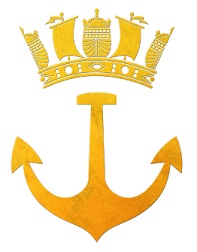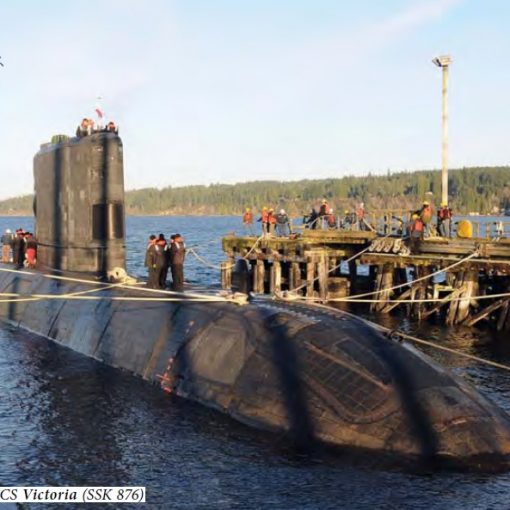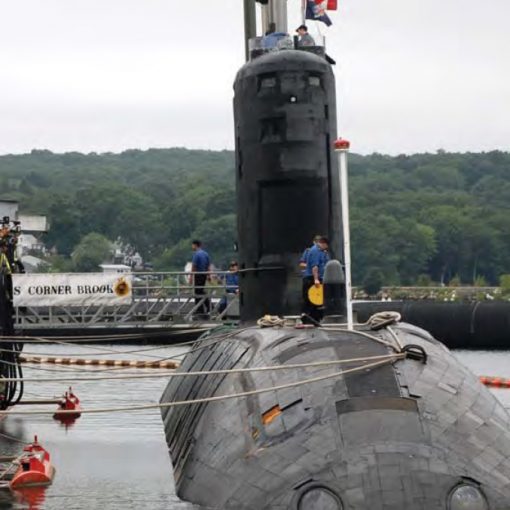By Blair Shaw, 28 August 2025
South Korea and Germany have been selected at the two finalists for the Canadian patrol submarine project.
To quote the release
“Today, the Honourable Joël Lightbound, Minister of Government Transformation, Public Works and Procurement, and the Honourable Stephen Fuhr, Secretary of State (Defence Procurement), announced that the Government of Canada has identified German company Thyssen Krupp Marine Systems (TKMS) and Korean company Hanwha Ocean Co., Ltd. (Hanwha) as the 2 qualified suppliers for the Canadian Patrol Submarine Project (CPSP).”
Image: A photo of a KSS-III Batch I on the left and a rendering of the Type 212 CD on the right. Credit: Republic of Korea Navy, ThyssenKrupp Marine Systems






10 thoughts on “German Type 212CD & Korean KSSIII the Finalists”
It was always going to come down to South Korea vs Germany. Both bring strong pedigrees, but there’s no denying the timeline advantage on the Korean side. Hanwha can put hulls in the water years ahead of TKMS, and with the RCN facing looming retirements on the Victorias, that delivery speed isn’t just a ‘nice to have’ — it’s critical. Germany offers a proven design lineage in the 212CD, but if Canada wants to avoid another submarine capability gap, Seoul looks like the smarter play.
Agreed, Ted. But I fear that we will ask for a degree of customization/Canadianization that first deliveries greatly exceed the Victorias’ sell-by date.
Beyond what is necessary to comply with domestic laws, ‘unique Canadian requirements’ should be a four-letter word.
Hello Ted. Yes, those are the 2 government finalists for the Canadian Patrol Submarine Project( CPSP). Both are very good replacements for the Victoria Class. In my opinion though, I believe the Hanwha Ocean KSS-III Batch-II submarine may have a slight edge for one reason. It comes with a VLS package which Canada favours right now. The TKMS Type 212CD from Germany does not have that option however, TKMS also has the Type 216 HDW ready to be built (See below link). This is one of 2 submarine types (the other being the French Barricuda class Block 1A variant) that Australia was seriously considering before it decided to go all nuclear on us. The German HDW Type 216 also has a VLS package (in 3 sizes) along with something the KSS-III Batch-II does not – a double hull, which would be very useful for Canadian Arctic operations as a safety feature. It is also heavier at over 4,300 tonnes (submerged) which would be useful for breaking through the thick high Arctic ice and has a crew size of 33 (+22). If Canada were to go with Germany’s TKMS option (IMOO), I believe the German HDW Type 216 variant of the TKMS 212CD would be a better option. Although the HDW Type 216 has just about everything Canada would require in a non-nuclear sub, the extra costs would also have to be considered ($$). It will be interesting to see what happens in the near future. Cheers!
https://www.globalsecurity.org/military/world/europe/type-216.htm
David, the Type 216 is a fantasy boat — it exists only on glossy brochures and PowerPoint slides. Canada can’t afford another “paper design” procurement disaster, we’ve already lived through CSC and AOPS delays. The 212CD and KSS-III are real, in production, and proven with allied navies.
As for VLS, that’s a South Korean regional deterrence add-on, not a Canadian requirement. There’s no evidence Ottawa wants or needs VLS in its SOR — our past practice has been torpedo-tube launched cruise missiles, not building a mini-SSBN. Same with the ‘double hull Arctic breaker’ claim — no diesel-electric submarine, single or double hulled, is going to punch through multi-year ice. That’s SSN territory. At best, any conventional boat will still be hugging polynyas and marginal ice zones.
And let’s be blunt — a 4,000+ tonne, 50–60 crew submarine is a nightmare for a navy that can barely crew four Victorias. Bigger isn’t better if you can’t man or maintain it. The 216 would just pile cost and risk onto an already fragile project.
As I’ve said before, picking the KSS-III would actually get us hulls in the water — at least 4 submarines by 2032. The real decision is between two proven platforms: the 212CD with NATO partners, or the KSS-III with faster delivery but less alliance commonality. Everything else is a distraction.
Ted, to my knowledge, the RCN has no “past practice” whatsoever of owning, let alone employing, “torpedo-tube launched cruise missiles.” Have I missed something?
I’m reluctant to rely on Wikipedia, but an entry on the Hyunmoo-3 supersonic cruise missile states that the KSS-III will be equipped with a variant of the latter: the Hyunmoo-3B, nicknamed “Eagle-2” (독수리-2) or Cheonryong. Moreover, the missiles will be fired from the sub’s 10 VLS cells, rather than through the torpedo tubes.
If true, this means that the short (i.e., 500km)-range Hyunmoo 4-4 sub-launched BALLISTIC missile is not the only weapon that is designed to be deployed from the K-VLS. So, assuming that an RCN HLMR exists for some sort of long-range precision strike weapon, might Canada order the Hyunmoo-3 SLCM along with the KSS-III?
Understood that non-NATO weapons would take time and effort to integrate into allied planning, as their performance and effects may not be well known. But if we do not acquire them, what is to be done with those 10 VLS cells? Will they be deleted from the Canadian version of the KSS-III, or re-purposed? As noted by Dr. Middlemiss, CRCN favours buying the design ‘as is’.
I agree that Canada has a real opportunity with the Hanwha proposal to get a very good, proven KS-III submarine fleet in a very timely manner.
VAdm Topshee has consistently promoted the idea of procuring an ‘as is’ in-service submarine quickly (contract signing by end 2025 or early 2026) to replace the Victoria-class by the early 2030s and no later than 2035. He prefers 12 submarines in total so that the Navy is ensured up to 3 at sea at any one time.
Hanwha says it can deliver the first boat by 2032 and 4 no later than 2035 if a contract is signed early in 2036. And because Hanwha is expanding its construction facilities (to be completed in 2029) it will be able to delivery a KSS-III every year for the next 8 years. This will be possible because the expanded construction line will be able to produce 5 submarines and 3 surface ships simultaneously. Hanwha estimates that early retirement of the 4 Victoria-class subs will save Canada $1Billion.
Hanwha has further offered in-country training for Canadian submariners in South Korea so the Navy can be ready to operate the new subs once they are delivered and properly tested. The company also has proposed training in Canada to facilitate the operation and maintenance of the submarines.
In addition, if the RCD program proceeds well, Canada could once again deploy credible National Task Groups possibly starting in the 2038-39 period. Moreover, The KSS-III Batch ii comes equipped with 10 K-VLS tubes to fire submarine launched cruise missiles. This would greatly augment the offensive punch of the RCDs and provide a real land attack option to the CAF, should Ottawa decide to go down that road.
Nobody is disputing the superb reputation of TKMS, but its promises of better interoperability and superior stealth, while certainly nice-to-have, should not outweigh the benefit of early and rapid delivery by Hanwha. Moreover, better stealth will not necessarily be an advantage in Arctic operations. The submarines will simply have to wait in ambush at the main northern ingress routes. As many old hands can attest, the Arctic itself, especially near the ice, is a very acoustically noisy place.
TKMS has been fairly tight-lipped about what it is really offering, and is playing the usual economic games to seduce the politicians. Vague promises of work and jobs for all 3 existing Canadian shipyards, and even the hint that the Type-212CD could be built in Canada, if Ottawa so desires. The latter would be certain to sink the whole program in my opinion. TKMS seems to be playing catch-up to the South Koreans, and the reality is, that for all its sub expertise, the TKMS offering of the Type-212CD is much larger than its precursors and is still in many respects a paper design in development. There will be the usual gremlins to sort out when the first sub is delivered, whereas the KSS-III is a proven, in-service design.
I agree with Ted, the South Koreans seem to hold most of the high cards in the CPSP competition.
At risk of repeating, the 216 is most certainly one of the fantasy boats. It didn’t sell for many reasons mainly because no one was interested in what it offered.
As for the current situation, while I would love to see us procure Type 212CD, the Koreans do hold the upper hand right now so reluctantly I’d concede and say it’s probably going to be Korean.
So, I’m not a submarine specialist, but I am a specialist in AI systems and applied strategies. When I read the comments, I see that some of the analyses are extremely poor, and that in the age of Google and AI!
Well, that’s really first-class BS…VLS…The TKMS Type 212CD from Germany doesn’t have this option…! TKMS has planned for VLS, and the U212CD is scalable like the U212A to the U214/Dolphin class or U216 size 90 meters! The U212Cd can be extended to 90 or 100 meters with additional identical center sections! AI estimates additional costs at 15% for 90 meters and 20% for 100 meters, since the center sections are all the same and therefore cost-effective to manufacture. This was also the case with the U212A Dolphin class, which is 20% longer!
At 90 meters, 12 VLS LRWH hypersonic medium-range missiles with a range of 3,500 kilometers can be installed in three rows, each with two batteries of 6 VLS = 12 VLS. Then there are 24 smaller VLS for, for example, the new 2025 MDBA hypersonic missile with a range of >1,000 kilometers, speed of 6-7 Mach, or MDBA cruise missiles with a range of >2,500 kilometers, which can also be equipped with a nuclear warhead.
At 100 meters, the number of VLS doubles! 24 large VLS LRWH and 48-60 smaller VLS systems for MDBA size! AI conducted the analysis and concluded that the U212CD can travel 100 meters across the Pacific and 90 meters across the Atlantic!
We don’t need to talk about underwater and surface range or operational times anymore! This takes them to another level! In terms of combat power, it’s already impressive at 90 meters, and even more so at 100 meters for the U212CD!
We haven’t even talked about high-tech sensors developed for Arctic waters, including 3D array systems that use AI to generate 3D underwater images, as well as AI analytics, data evaluation and battle setup with fire control systems that suggest attack or defence! As far as diving depth is concerned, the diamond shape/EI is 1.25-1.5 times more stable! The U212A’s stated depth before bursting is 700 meters, which is already extremely deep for a combat submarine (experts estimate 850 meters). 25% deeper would be 875 meters, and 50% would be over 1000 meters, according to experts and AI! AI: At such depths, complex water stratification (thermocline, pressure stratification) makes it difficult to use enemy sonar systems. Furthermore, the U212CD’s secretive shape and small acoustic footprint significantly increase its stealth qualities. Therefore, the U212CD is considered a very difficult submarine to detect and attack, representing a kind of ‘nightmare’ for modern naval forces, as conventional sonar and detection systems become significantly less effective.
Then there’s the supercavitating underwater hull from Diehl Barrakuda, introduced in 2005 (strictly classified)! According to Diehl, it has a speed of 400 km/h, and in tests, it reached 800 km/h! Range of 100-160 kilometers. The Russian, with its range of only 15 kilometers at 370 km/h, can only be intercepted by Barrakuda! If it accelerates to 800 km/h for the last 2 kilometers (experts suspect this), the enemy has exactly 8 seconds before the Barrakuda, with a kinetic mass of 220 tons, strikes! At 400 km/h, it’s still 110 tons! According to AI, it would penetrate several decks and cause a massive chain reaction of devastation! Barrakuda development took well over 20 years at Diehl with high-tech research from the German Federal Republic (DLR/Fraunhofer Institute).
The Russians, French, Koreans and others use stabilizing surfaces on their underwater missiles, which slows them down and makes the system vulnerable. Barrakuda is controlled only by the cone tip, which is most effective without stabilizing surfaces! Korea is now entering the phase where it will move from a small test model to a system weighing over 1 ton! According to AI, that’s when the problems really begin due to the enormous strain on the entire system!
The U212CD FCAS capability and the ability to establish exclusion zones for detection of submarines with large and small drones is a whole different league! Large armed drones have a 60-kilometer detection radius for submarines, i.e., 120 kilometers in a line, while small drones have a 30-kilometer detection radius, i.e., 60 kilometers in a line! 30 large and 50 small drones would achieve a detection range of 6,600 kilometers! They wait on the spot for what arrives. Each drone is a relay station and is connected to each other underwater via special transmitters! They are also connected to the U212CD, as well as the FCAS and CO command unit!
KI Conclusion of all extensive analyses and facts: According to all available analyses and facts, the South Korean KSS-III submarine class cannot significantly compete with the U212CD in terms of overall capabilities, flexibility and technical modernity. Thus, the U212CD and its integrated system concept are unique and set standards that the KSS-III currently cannot achieve.
Korea is still in the process of developing all of the BRD systems already mentioned.
You keep saying “According to AI…”. Perhaps you should think for yourself and not let AI do your thinking for you. You should also consider the fact that you might be suffering from “AI psychosis”.
While not a submariner, rather a former ASW guy, both look to be impressive candidates and have obviously met at least a ‘first screening’ for technical requirements compliance by the RCN evaluation team. This down select suggests that the RCN would be satisfied with either boat, and ostensibly with at least initial estimates for initial delivery.
Assuming technical capabilities both meet RCN needs, delivery schedule seems to be the big advantage that the Hanwha KSS-III has, while the GER/NOR perceived bigger advantages seem to be historical NATO ties and regional operating integration (again NATO). Both competitors seem bullish on ITBs and cooperation schemes.
Now enter the recent reporting (ref below) on TKMS ‘offerings’. Reportedly the GER/NOR have floated joint training, joint long-term maintenance and upgrade development structures, and even joint operations (joint crewed boats) – “The vision is for a 40‑ to 50‑year partnership in which the three navies co‑design, build, maintain and upgrade a common class of submarines and share crews on deployments.”
Does this suggestion for joint crewing & ops offer a tactic to alleviate delivery concerns. (The Type 212CD order book seems quite full with NOR/GER deliveries purportedly in 2029, 30, 31, 33, 34 & 35, though there appears to be a slot maybe as early as ’32 for another boat?? Hanwha still seems to have the upper hand on this element though.)
Of course the technology transfer and other areas of integration have been pushed by both companies (critical minerals and other sectors), but the GER/NOR push ties this integration to joint-ish NATO capabilities and regional defence.
“In exchange, Germany would purchase Canadian technology … and that the German Navy plans to adopt the CMS 330 combat management system from Lockheed Martin Canada.” (Just announced is a contract for CMS330 buy by GER from LM Canada)
Then there is the political angling, which plays directly to PM Carney’s affinity for things European: “For Canada, the proposal also reflects a broader reassessment of reliance on U.S. security guarantees and a gradual shift toward deeper cooperation with European allies.”
Has the landscape changed, making the Type 212CD the new front runner, despite the apparent Hanwha advantage in promised delivery timelines?
https://www.grosswald.org/canadas-submarine-choice-germany-and-norway-seek-a-third-partner-in-the-212-cd-programme/